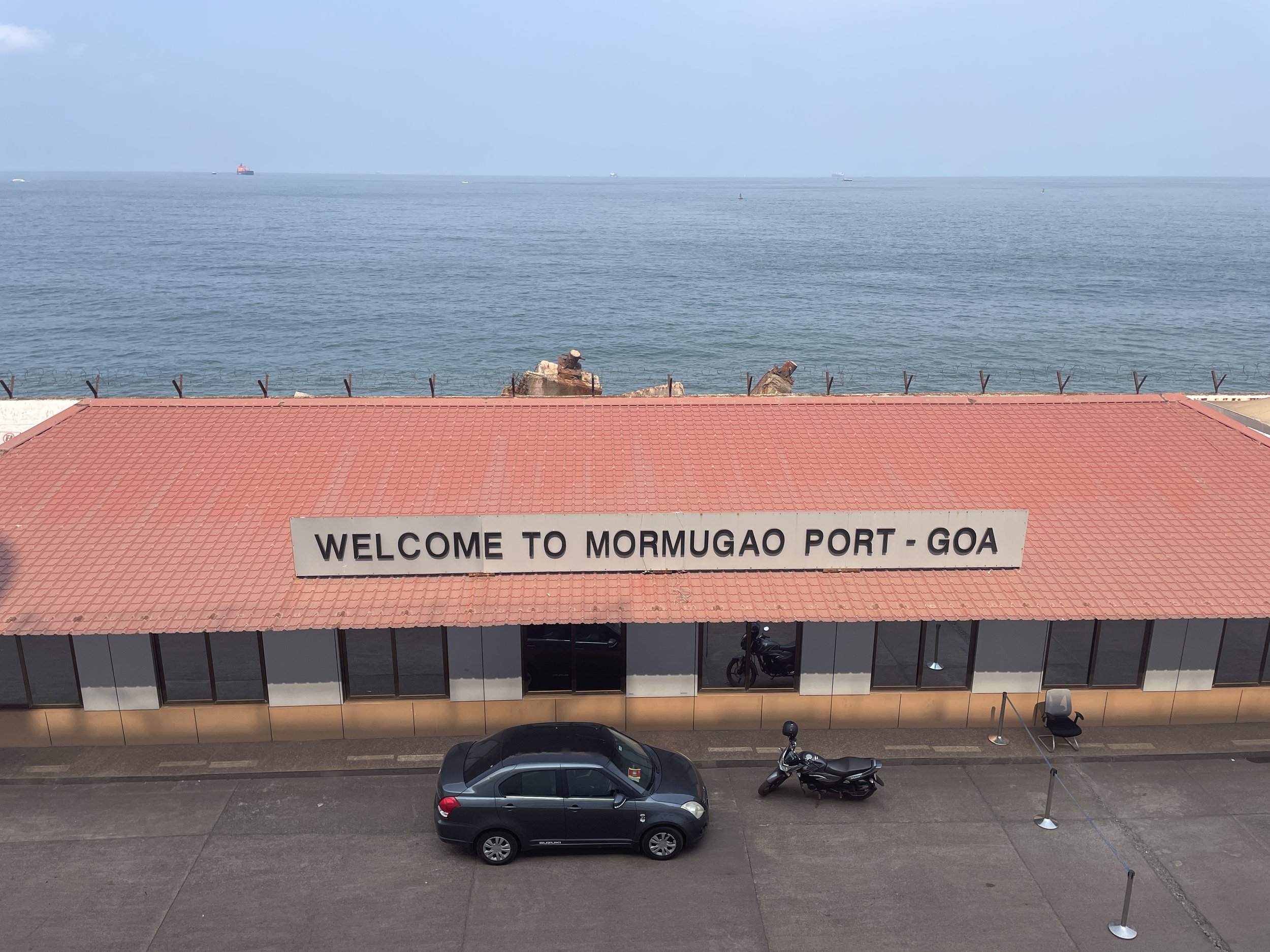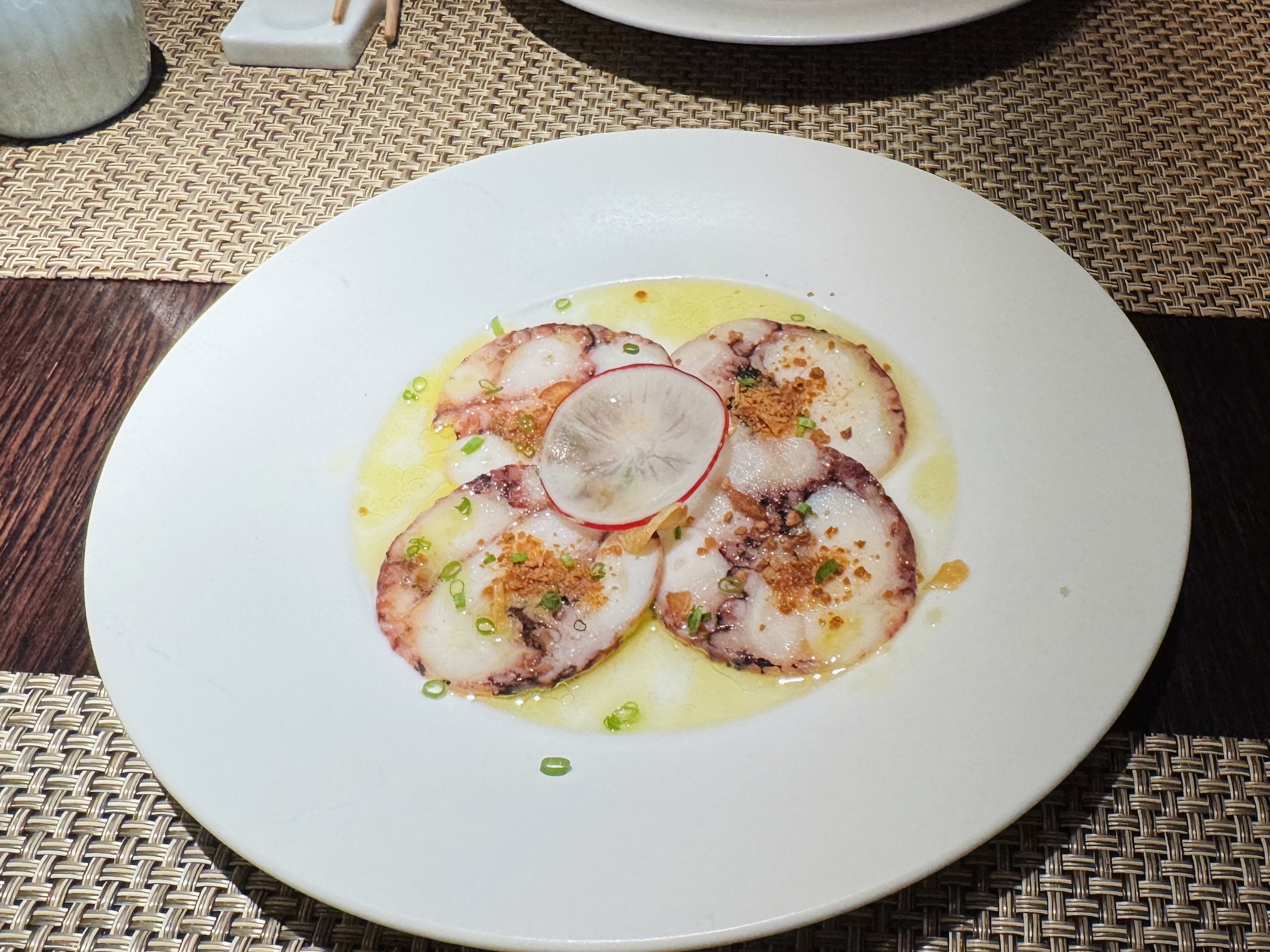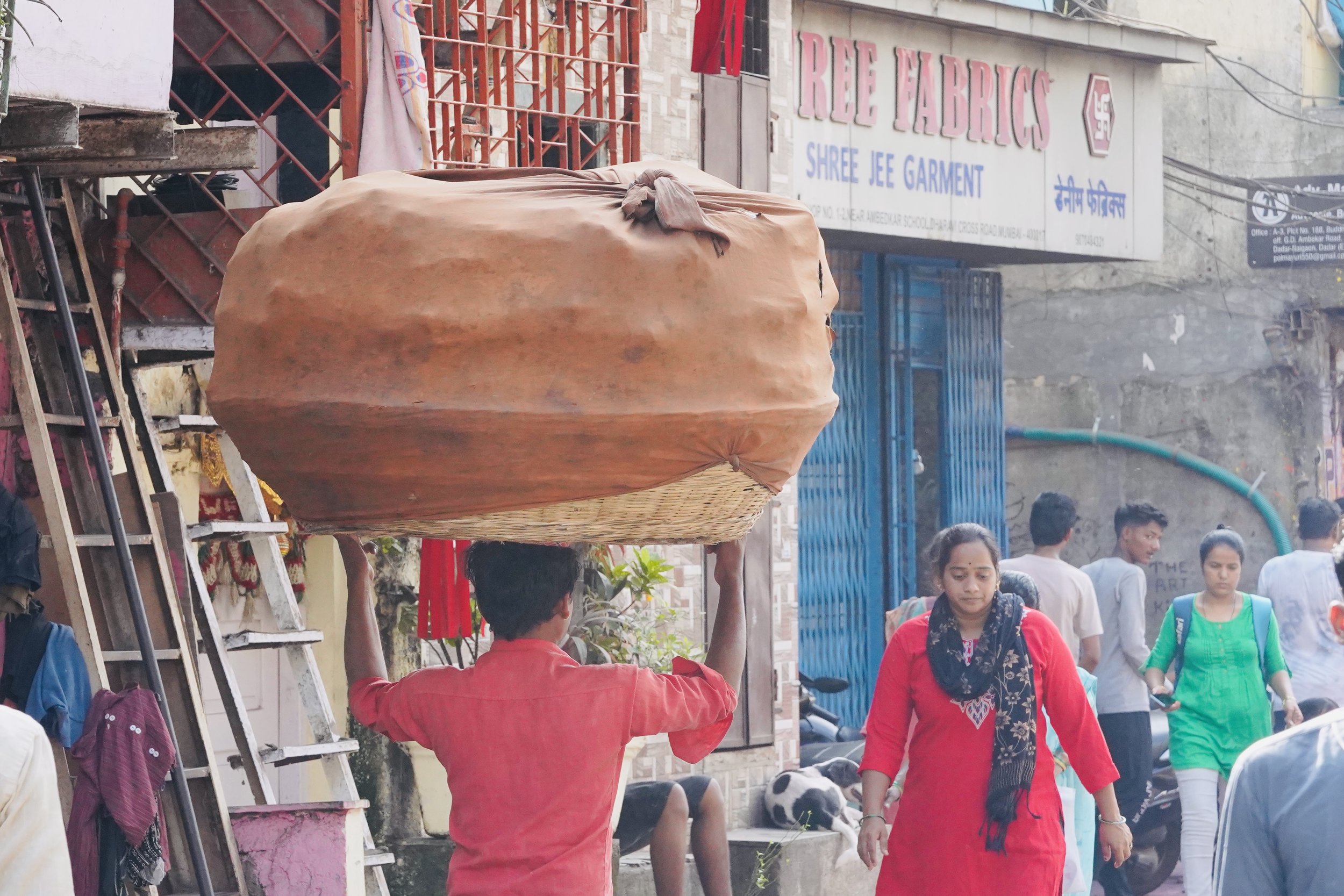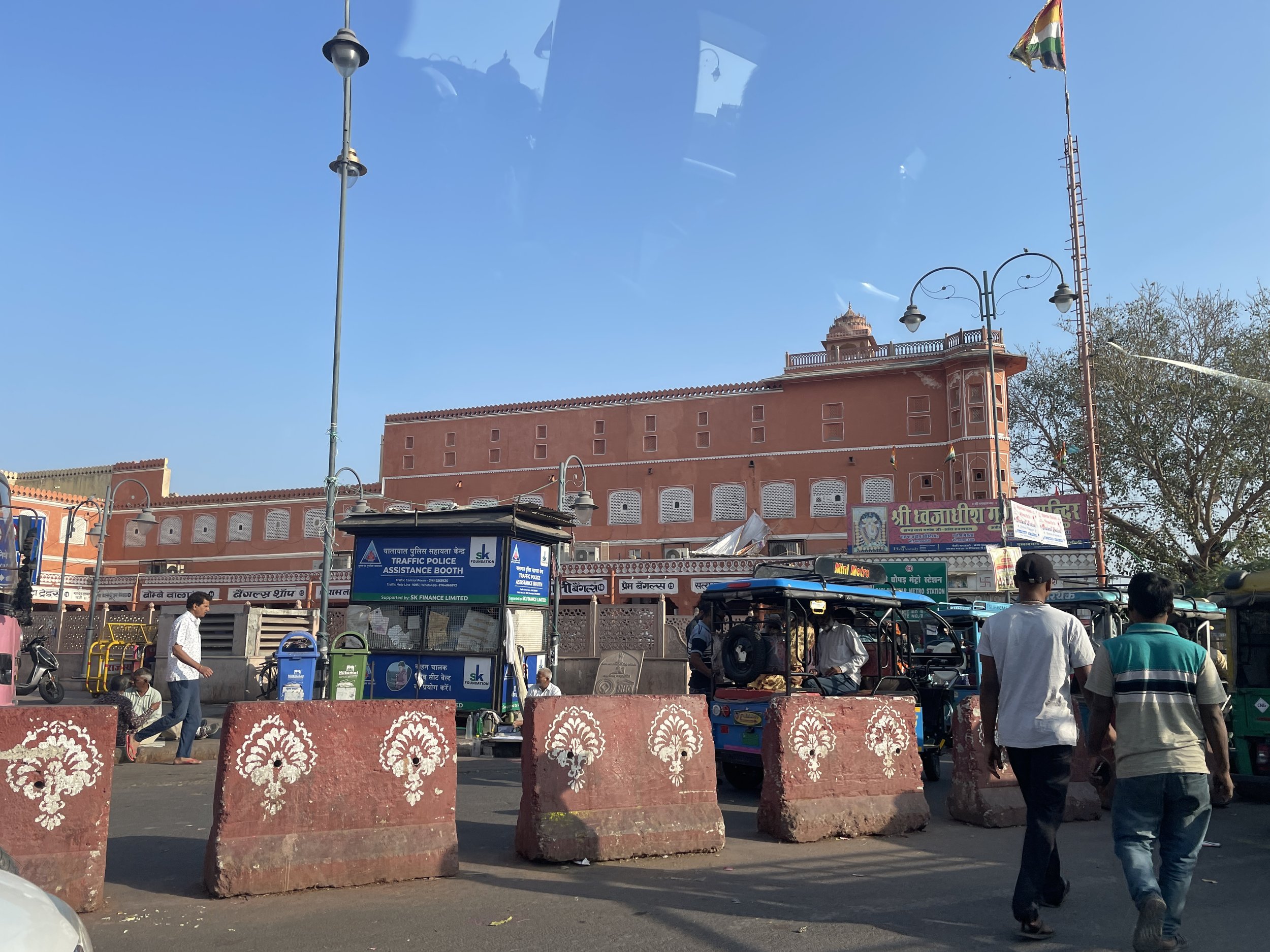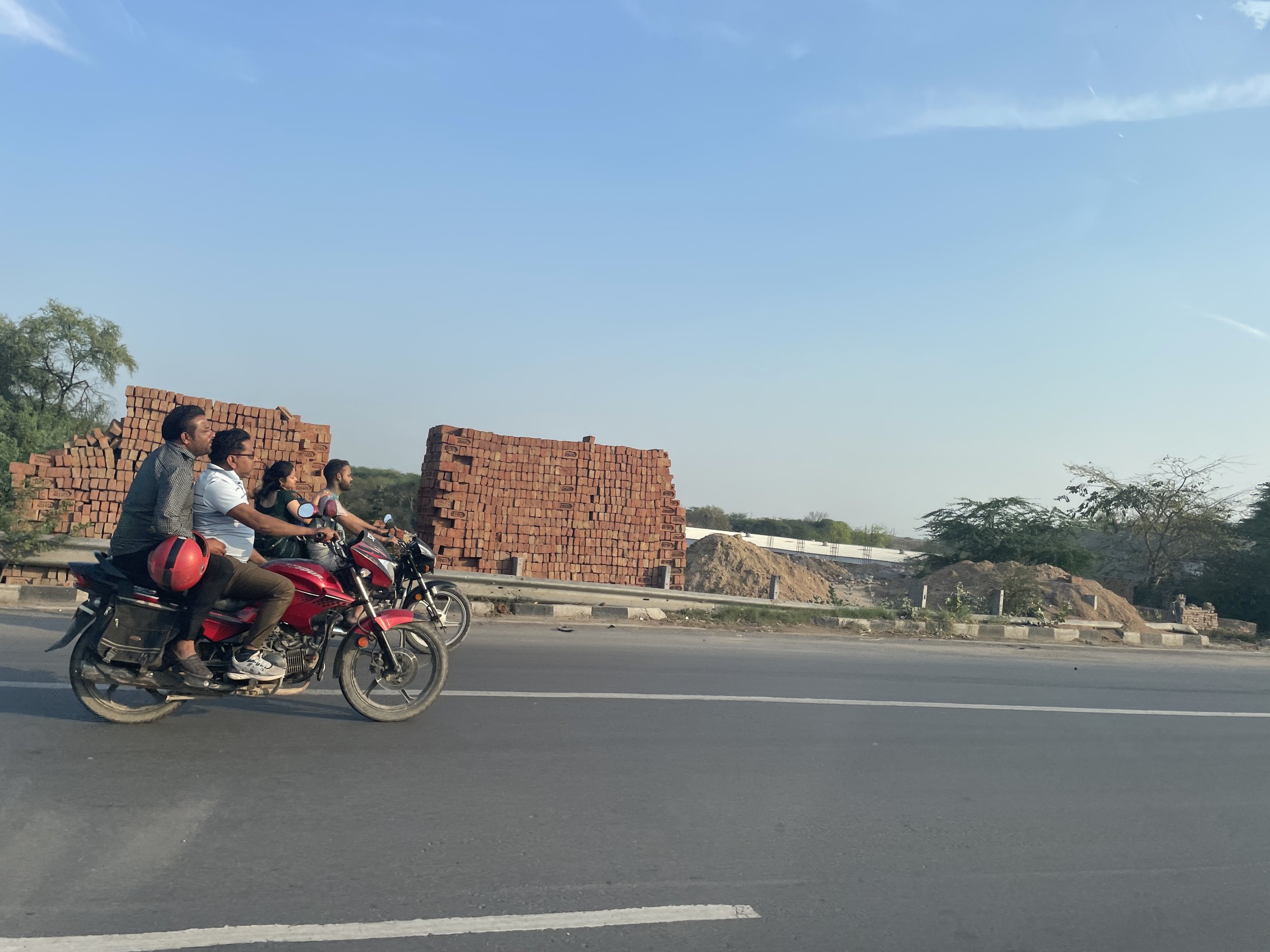Exploring Old Goa 老果阿
March 19, 2025
Disembarking at the Mormugao cruise terminal,…..
今天是这次邮轮的第一站,。。。
March 19, 2025
Disembarking at the Mormugao cruise terminal, we set out to explore the historic churches of Old Goa, a UNESCO World Heritage Site known for its grand Portuguese-era architecture and deep Christian heritage. To make the most of our limited time, we hired a taxi, which initially quoted $90 for the tour, but after negotiation, we settled on $50—still well above the local rate.
The 45-minute drive to Old Goa took us through lush tropical landscapes, offering glimpses of the region’s rich history beyond its famed beaches.
Our first stop was the Basilica of Bom Jesus, one of the most famous churches in India and a UNESCO-listed Baroque masterpiece. The church is best known for housing the remains of St. Francis Xavier, whose tomb lies within. No photography is permitted inside, which added to the solemnity of the experience. The basilica’s grandeur and historical significance made it a meaningful start to our tour.
Next, we walked across the street to Se Cathedral, one of the largest churches in Asia. The vast white façade and golden altarpiece were impressive, but the experience of walking under the scorching sun to reach the entrance made us realize just how intense the Goan heat could be.
Our third stop was the Church of St. Francis of Assisi, a unique fusion of Manueline, Tuscan, and Baroque architectural styles. The adjoining museum housed colonial-era artifacts, religious paintings, and sculptures, offering a deeper look into Goa’s Portuguese legacy. However, with no air conditioning inside, the heat was unbearable, so we walked through quickly, barely taking in the details. We then made a quick stop at the Chapel of St. Catherine, one of the lesser-visited sites in Old Goa.
Our last stop in Old Goa was the St. Augustine Tower, one of the region’s most iconic ruins. Originally part of the St. Augustine Church, the 46-meter-high tower is all that remains of what was once one of the largest churches in Goa. Unlike the crowded basilicas, this area was nearly deserted, allowing us to take in the grandeur of the crumbling structure in solitude. The contrast between the well-preserved churches and these haunting ruins made this one of the most memorable stops of the day.
On our way back to the cruise terminal, we made a brief stop in Vasco da Gama town to visit Shri Narsimha Sateri Devi Temple, a small yet significant temple for the local Hindu community. We also paused for a photo at the Old Vasco Clock Tower, a historic landmark that once served as the town’s central timepiece.
This tour marked the end of our one-week visit to India, a journey filled with unexpected experiences and lasting impressions. India offers a vibrant blend of contrasts—where overwhelming crowds and never-ending honking meet warm hospitality, and where grand palaces and modern skyscrapers stand beside bustling slums. The resilience and ability to survive in challenging conditions left us with admiration and deep respect for the people of this fascinating country.
After returning from the tour, we dropped by the Bistro for a few light snacks. Dinner was at the long-awaited UMI UMA by Nobu, our favorite Japanese restaurant on the cruise. We ordered many of our usual favorites and also tried a new dish—Crispy Rice with Spicy Tuna Tartare. The deep-fried rice cakes reminded us of Chinese ci fan gao (sticky rice cakes). We liked it so much that after finishing the first plate, we ordered a second one.
老果阿
2025年3月19日
今天是这次邮轮的第一站,抵达莫尔穆冈(Mormugao)邮轮码头后,我们踏上了探索老果阿(Old Goa)的旅程。这座城市被联合国教科文组织列为世界文化遗产,以其宏伟的葡萄牙殖民时期建筑和深厚的基督教文化而闻名。旧果阿离我们的船码头有些距离,在码头外,我们租了一辆出租车,起初司机开价90美元,经过一番讨价还价,我们最终以50美元成交——但仍远高于当地的价格。
经过45分钟车程,我们的第一站是邦波耶稣大教堂(Basilica of Bom Jesus),这是印度最著名的教堂之一,也是一座联合国教科文组织列出的巴洛克风格杰作。教堂最为著名的是保存完好的圣方济·沙勿略(St. Francis Xavier)遗体安息在华丽的圣棺中,吸引着世界各地的朝圣者。教堂内部禁止拍照。
接下来,我们冒着炎炎烈日穿过街道,前往圣凯瑟琳大教堂(Se Cathedral)。这座教堂是亚洲最大的教堂之一,洁白的外墙和镀金的祭坛令人叹为观止。然而,在炙热的阳光下步行并不轻松,我们很快意识到果阿的酷暑是多么让人难以忍受。
我们的第三站是圣方济各·阿西西教堂(Church of St. Francis of Assisi),它融合了马努埃尔式、托斯卡纳式和巴洛克式建筑风格。毗邻的博物馆收藏了殖民时期的文物、宗教绘画和雕塑,展示了果阿深厚的葡萄牙文化遗产。然而,博物馆没有空调,闷热难耐,我们只能快速浏览后匆匆离开。随后,我们短暂停留在圣凯瑟琳小教堂(Chapel of St. Catherine),这是一处较少游客造访的历史遗迹。
在老果阿的最后一站,我们来到圣奥古斯丁塔(St. Augustine Tower),这里是该地区最具标志性的遗迹之一。曾经的圣奥古斯丁教堂如今仅存下一座高46米的塔楼,而这座教堂曾是果阿最大的教堂之一。站在遗迹之间,我们不禁想象着当年的辉煌景象。这座教堂因被遗弃和年久失修而逐渐倒塌,如今只剩下这座孤独的塔楼,与我们刚刚参观的完好无损的教堂形成鲜明对比。幸运的是,这里游客稀少,只有我们两人,让我们得以静静欣赏这片宁静而神秘的遗址。
在返回邮轮码头的途中,我们短暂停留在瓦斯科达伽马镇(Vasco da Gama),参观了Shri Narsimha Sateri Devi神庙,这座小型的印度教寺庙对当地社区具有重要意义。随后,我们在瓦斯科老钟楼(Old Vasco Clock Tower)前停留拍照,这座葡萄牙殖民时期的历史地标,曾是该镇的中心时钟。
今天的旅程标志着我们为期一周的印度之行的结束,这次的印度游有着许多意想不到的经历,给我们留下深刻的印象。
晚餐是期待已久的UMI UMA by NuBu, 邮轮上我们最喜欢的日本餐厅。点了许多以前常吃的东西,还尝试了新口味CRISPY RICE WITH SPICY TUNA TARTARE, 油炸的米饭糕块像中国的糍饭糕,吃完一份又叫了第二份。
Back on Crystal Cruises 重回水晶邮轮
March 18, 2025
Our weeklong journey through India was coming to an end……
近一周的印度游接近尾声,。。。
March 18, 2025
Our weeklong journey through India was coming to an end. Today, we were set to embark our beloved Crystal Cruises ship in Mumbai, marking the start of our next voyage—this time sailing from India to South Africa.
After breakfast, we took a stroll along the Marine Drive just outside our hotel. It was fairly quiet in the morning, though this seaside promenade—often called the most romantic stretch in Mumbai—is packed with people by night. We returned to the hotel to check out and ordered a car to the cruise terminal. To our surprise, the car that arrived didn’t have a trunk. As we were still wondering what to do with our suitcases, the driver and hotel staff expertly hoisted both pieces of luggage onto the roof—clearly a routine move for them.
After passing through multiple rounds of security checks at the port, we finally boarded the Crystal Symphony—the same ship we sailed on last summer in Spain. As per tradition, we headed straight to the buffet for a hearty meal. Although we both enjoy Indian cuisine, after a full week of it, we were ready for a change. Returning to familiar flavors felt like coming home.
At the end of last year, the cruise line replaced its former Asian restaurant with the only BeefBar at sea, part of a world-renowned luxury dining brand famous for its top-quality beef and creative dishes. Tonight, we decided to give it a try. Everything on the menu was included except the Kobe steak, which came at a hefty $500 per piece. We ordered Angus steaks, which were excellent, and the Korean-style beef buns were a creative twist.
At 7 p.m., the ship set sail from Mumbai, accompanied by the song “What a Wonderful World.” As usual, the evening show was scheduled for 9:15 p.m. While the first night’s performance tends to follow a familiar format, we still went along for the fun of it—just part of the cruise experience.
重回水晶邮轮
2025年3月18日
近一周的印度游接近尾声,今天我们将在孟买(Mumbai )再一次登上我们钟爱的水晶邮轮公司(Crystal Cruises)的船,开启我们从印度到南非的邮轮之旅。
早餐后先去酒店门外的海滨大道走了走,人不多。这条被称为最浪漫的大道晚上是人满为患。接着回酒店退了房,叫了车去船码头。没想到等来了一辆没行李车厢的小车,我们俩还在想箱子该怎么办,司机和酒店人员已经熟练地把二个行李箱放到车顶上。
来到船码头,经过一遍又一遍的核查终于踏上水晶交响号(Crystal Symphony), 她是我们去年夏天在西班牙坐过的同一艘邮轮。老规矩,我们上船后直奔自助餐厅,好好地美餐了一顿。虽说我们俩喜欢印度饭,但一星期下来已吃腻,终于可以换口味了,回到熟悉的世界多好。
邮轮在去年底将之前的亚洲餐厅改为海上唯一的一家BeefBar, 它是享誉全球的高端餐厅品牌,以其顶级牛肉和创新料理而闻名。今天晚上我们就去尝个新鲜。菜单上除了Kobe 牛排是额外收费($500 一块牛排),其它所有的美食都随便吃。我们要的Angus牛排的确不错,韩国肉包子也有新意。晚上七点我们的船在“What a wonderful world”的歌声中离开孟买(Mumbai)。音乐演出照旧安排在晚上9:15,其实这邮轮每次的第一场演出几乎都是一样的,第一天上船,我们也就去凑个热闹。
Half-Day Mumbai and Slum Tour 孟买半日游与贫民窟之行
March 17, 2025
Our tour began from our hotel, Oberoi Hotel……
昨晚飞到Mumbai。。。
March 17, 2025
Our tour began from our hotel, Oberoi Hotel, with a drive along Marine Drive, the iconic boulevard known as the “Queen’s Necklace,” offering stunning views of the Arabian Sea.
Our first stop was Dhobi Ghat, the world’s largest open-air laundry, where hundreds of washermen (dhobis) hand-wash clothes for hotels, businesses, and individuals using traditional techniques and makeshift washing machines. Watching them work efficiently in this massive outdoor setup was fascinating.
Next, we visited the Gateway of India, a historic archway built during the British colonial era. Though under renovation, the waterfront remained bustling, with boats anchored offshore.
Driving through the city, we passed Chhatrapati Shivaji Maharaj Terminus (CST), a UNESCO-listed railway station with grand Victorian Gothic architecture, and Oval Maidan, where locals played cricket against the backdrop of the Rajabai Clock Tower.
Our next stop was Crawford Market, one of Mumbai’s oldest and most famous markets. After a brief walk through its bustling alleys, we headed to the Hanging Gardens on Malabar Hill. Lush and peaceful, the gardens offered a welcome escape from the city and provided sweeping views of Mumbai’s skyline and the Arabian Sea. What surprised us, however, was the guide’s explanation that the green, tree-covered area next to the garden is home to Mumbai’s famous Towers of Silence. Looking up, we noticed numerous vultures circling in the sky, a solemn reminder that the Parsi tradition of sky burials, practiced for over a thousand years, continues to this day.
Our final stop in the first half was Mani Bhavan Gandhi Museum, once Gandhi’s headquarters in Mumbai. The museum highlighted his life and contributions to India’s independence.
Afterward, our driver dropped us off at the tour company’s small office, where we had about 30 minutes before our slum tour began. We took the opportunity to relax at a nearby café, enjoying a latte and a chocolate croissant, before meeting our guide—a local who was born, raised, and still resides in Dharavi, Asia’s largest informal settlement.
Dharavi is often described as a slum, but stepping inside, we quickly realized it is far more than that. It is a bustling economic powerhouse, home to over two million people and countless small businesses. It also houses one of the world’s largest recycling industries, contributing significantly to Mumbai’s economy.
Walking through its narrow alleys, we saw workshops where artisans crafted leather goods, potters shaped clay, and recyclers processed discarded materials into something useful. Despite poor infrastructure and limited water supply, the resilience and resourcefulness of Dharavi’s residents were remarkable.
The tour left us with a deeper understanding of Mumbai’s contrasts—its wealth and struggles, tradition and progress, and the determination of its people.
孟买半日游与贫民窟之行
3月17日
昨晚飞到Mumbai ,接机的司机已经在机场门口等着我们。顺利入住酒店,终于可以好好休息。
今天我们的包车游从酒店门前的海滨大道(Marine Drive)开始。这条标志性的海滨大道被誉为“女王的项链”,沿途可欣赏到阿拉伯海的壮丽景色。
我们的第一站是塔塔洗衣场(Dhobi Ghat),世界上最大的露天洗衣场。成百上千的洗衣工(dhobis)在这里使用传统手洗技术或者简易洗衣机为酒店、商家和个人清洗衣物。在这片巨大的户外洗衣场中,他们工作场面令人惊叹。
接着,我们参观了印度之门(Gateway of India),这座历史悠久的拱门建于英国殖民时期。尽管正在维修,海滨仍然热闹非凡,水面上停泊着众多船只。
穿越城市,我们途经贾特拉帕蒂·希瓦吉终点站(Chhatrapati Shivaji Maharaj Terminus, CST),这座列入联合国教科文组织世界遗产的火车站,以宏伟的维多利亚哥特式建筑闻名。随后,我们经过椭圆广场(Oval Maidan),这里的草地上,当地人正在打板球,而背景则是宏伟的拉贾拜钟楼(Rajabai Clock Tower)。
下一站是克劳福德市场(Crawford Market),是孟买最古老、最著名的市场。在那里转了一圈,我们来到在马拉巴尔山(Malabar Hill)的悬空花园(Hanging Gardens),这里绿意盎然,环境幽静,可俯瞰孟买市区和阿拉伯海的壮观景色。有点出乎我们的意料的是导游介绍说花园隔壁那一片绿树覆盖的地方就是Mumbai出名的沉默之塔(Towers of Silence)所在地,抬头看见不远处天空上无数秃鹫在盘旋,帕西人千年以来为逝者进行天葬的传统沿续到今天。
上半部的最后一站是马尼·巴范甘地博物馆(Mani Bhavan Gandhi Museum),这座历史悠久的两层建筑曾是甘地在孟买的总部。馆内展示了甘地的生平事迹及其对印度独立运动的贡献。
随后,司机将我们送到旅行社的小办公室与后半段的导游见面。因为我们接下来的贫民窟之旅还有半小时才开始,在烈日下走了四个半小时的我们又饥又渴,于是就在旅行社附近的一家咖啡馆稍作休息,享用了美味的拿铁和巧克力可颂。
一位出生并仍然居住在达拉维贫民窟(Dharavi Slum)的当地向导带我们参观了亚洲最大的非正式住区之一,达拉维。
达拉维常被称为贫民窟,但当我们走进其中,才发现它远不止如此。这里是一个充满活力的经济中心,居住着超过两百万人,也是无数小企业的家园。这里还是全球最大的回收产业中心之一,对孟买经济有着重要贡献。
穿行在狭窄的巷道里,我们看到工坊里手艺人制作皮革制品,陶艺师捏制陶器,回收工人则将废弃材料重新加工,使其焕发新生。尽管基础设施有限,供水时间每天仅三小时,但这里的人们依然展现出惊人的韧性和创造力。
这次旅程让我们更加深入地理解了孟买的贫富对比与反差——它的繁华与困境、传统与现代,以及人们坚韧不拔的精神。
Golden Triangle 3-Days Tour — Jaipur 金三角包车游—斋浦尔
March 16, 2025
After leaving Agra yesterday,……
昨天离开阿格拉(Agra) 后,。。。
March 16, 2025
After leaving Agra yesterday, we drove to the final stop of our Golden Triangle journey—Jaipur, a city often referred to as the Pink City due to the rose-colored buildings that dominate its old town.
After breakfast, our driver picked us up from the hotel, then collected our local guide for the day. Our first stop was the iconic Hawa Mahal, or Palace of Winds, one of Jaipur’s most recognizable landmarks. This pink-hued palace features 953 small windows, designed not just for aesthetics, but to allow royal women to observe the street scenes outside without being seen.
Next, we headed to Amber Fort, Jaipur’s most famous historical site, perched atop the Aravalli Hills. Originally built by Raja Man Singh I in 1592, the fort was expanded over generations into a grand complex that functioned as a military stronghold, royal palace, and sacred space all in one.
We chose not to ride elephants up the hill and instead had our driver take us directly to the entrance at the top. Along the way, we passed through narrow streets of the old city and stopped at the Panna Meena ka Kund, a traditional 16th-century stepwell used for water collection. Its geometric symmetry and intricate design were truly mesmerizing.
At Amber Fort, we watched many tourists arriving on elephant-back through the Suraj Pol (Sun Gate), creating a scene that felt straight out of the Rajput era. The most breathtaking part was the Sheesh Mahal, or Hall of Mirrors, its walls embedded with thousands of tiny mirrors that glittered in the light.
Although it was a Hindu royal residence, the fort’s architecture is also heavily influenced by Islamic design. Raja Man Singh I built separate quarters for each of his twelve queens, connected by a secret passageway that allowed the king to visit any queen in private. Our guide led us through this hidden corridor—it felt like peeking into a forgotten world of palace intrigue.
Standing atop the high ramparts of Amber Fort, the views of the surrounding landscape are truly breathtaking. You can gaze out over rolling hills of the Aravalli range, their rugged outlines stretching across the horizon. Below, the tranquil waters of Maota Lake glimmer in the sunlight, with the delicate pattern of Kesar Kyari Bagh, a geometric garden island, visible at its center. To one side, long fortification walls snake along the ridgelines like a stone ribbon, protecting the old city and blending into the hills—evoking images of the Great Wall of China. In the distance, you can spot tiny villages, temples, and palaces, dotting the dry, sunbaked terrain.
Later, we visited the Jal Mahal, or Water Palace, which sits quietly in the middle of Man Sagar Lake. Submerged partially by the lake, only the upper two of its five stories are visible above water. Since the palace is not open to the public, we admired it from the lakeshore and took photos.
Our next stop was Jantar Mantar, an UNESCO World Heritage Site built in 1724 by Maharaja Jai Singh II. This astronomical observatory features the world’s largest sundial (Samrat Yantra), accurate to within two seconds. The site also houses many other massive instruments used to measure time, track stars, and observe planetary movements—a testament to India’s advanced astronomical knowledge at the time.
We concluded our day at the City Palace, part of which is still the residence of Jaipur’s royal family. The sections open to the public showcase a fusion of Rajasthani and Mughal architecture, and exhibit a fascinating collection of historical artifacts, royal garments, and weaponry—each piece telling the story of a bygone era of opulence and power.
With this, our Golden Triangle tour came to a close. In the evening, we had an 8 PM flight to Mumbai, so our driver dropped us at the airport. We had planned to have dinner there, only to find that the pre-security area had almost no food options. With a few hours left before check-in, we simply waited at the airport, reflecting on the unforgettable memories from the past few days.
金三角包车游——斋浦尔
2025年3月16日
昨天离开阿格拉(Agra) 后,我们驱车前往金三角之旅的最后一站——斋浦尔(Jaipur),这座城市因其老城区的大部分建筑为粉红色,而被称为 “粉红之城”(Pink City)。
早餐后司机来酒店接我们,然后又去接今天的当地导游。今天的第一个景点风之宫殿,它是斋浦尔最具代表性的建筑之一。这座粉红色的宫殿拥有953 扇窗户,其设计目的不仅仅是为了美观,而是为了让宫廷女子在不被外人看见的情况下,透过窗户观看街道上的活动。
接着,我们驱车前往琥珀堡,这是斋浦尔最著名的历史遗迹之一,坐落在阿拉瓦利山脉(Aravalli Hills) 之上。堡垒最早由 拉贾·曼·辛格一世(Raja Man Singh I) 于 1592 年 建造,随后几代统治者不断扩建,使其成为一座集军事要塞、皇宫和宗教圣地于一体的壮丽宫殿。
我们没有选择骑大象上山,而是由司机直接送到山顶入口。从狭窄的古城小街穿过,我们先来到帕纳米纳阶梯井(Panna Meena ka Kund)。这座 16世纪修建的传统阶梯井,曾用于雨水收集,几何对称的阶梯设计令人叹为观止。
到达琥珀堡,我们看到许多游客骑着大象从 太阳门(Suraj Pol) 进入堡垒,仿佛穿越回了数百年前的拉贾斯坦王朝。最让人惊叹的是胜利大厅(Sheesh Mahal),也被称为 “镜宫”,其墙面镶嵌着无数小镜片。
琥珀堡不仅是一座印度教国王的城堡,其建筑也深受伊斯兰风格影响。曼·辛格一世为他的十二位王妃修建了独立的生活区,其中一条秘密通道让国王可以随时进入任何一位王妃的住所。导游带着我们走过这条隐秘小径,仿佛窥探到往日宫廷生活的秘密。
随后,我们来到贾尔·玛哈尔(Jal Mahal),又称水上宫殿,它静静地矗立在 曼萨加尔湖(Man Sagar Lake) 之中。宫殿的下面三层已被湖水淹没,仅有二面二层露出水面。由于宫殿不对外开放,我们只能在湖边欣赏并拍照留念。
接下来,我们前往简塔·曼塔天文台(Jantar Mantar),这座联合国教科文组织(UNESCO)世界文化遗产 由 贾伊·辛格二世(Maharaja Jai Singh II) 于 1724 年 建造。这里拥有世界上最大的 日晷(Samrat Yantra),时间误差可精准至 2 秒,此外还有许多用于测量时间、星象和行星运动的巨大天文仪器,充分展现了当时印度在天文学领域的先进水平。
最后,我们参观了 城市宫殿(City Palace),这是一座仍然由斋浦尔王公家族居住的宫殿。宫殿内部对公众开放的部分展示了 拉贾斯坦与莫卧儿建筑风格的融合,馆内珍藏着历史文物、皇家服饰和武器,每一件展品都诉说着昔日王朝的辉煌。
至此,我们的金三角之旅 画上了句号。晚上,我们已预订了 8 点飞往孟买(Mumbai)的航班,于是让司机送我们去机场。原计划在机场内用餐,但到达后才发现安检前的候机区域几乎没有餐饮店。由于距离值机还有几个小时,我们也只能在机场耐心等待,回味这几天的精彩旅程。
Golden Triangle 3-Days Tour – Agra 金三角包车游—阿格拉
March 15, 2025
Yesterday afternoon, we drove for over three hours……
昨天下午驱车三个多小时从新德里来到阿格拉,。。。
March 15, 2025
Yesterday afternoon, we drove for over three hours from New Delhi to Agra and went straight to the hotel to rest.
Early this morning at 6 a.m., our driver arrived at the hotel on time to pick us up. After a short drive, we reached one of the Seven Wonders of the World—the Taj Mahal. We met our local guide at the entrance, who then led us into the site. A quick note here: security checks at the Taj Mahal are separated by gender, and all small bags must go through security scanning, separated from their owners for some time. After the check, visitors have to squeeze through the crowd to find their bags on a long table behind a jam-packed conveyor belt—extremely chaotic and quite insecure.
Even though we had seen countless photos and films of the Taj Mahal, witnessing it in person was still awe-inspiring. Our guide shared the history with us: the Taj Mahal was commissioned by Mughal Emperor Shah Jahan in memory of his wife Mumtaz Mahal, and took 22 years (1632–1653) of meticulous craftsmanship to complete. Since we arrived early, the crowds weren’t too overwhelming, but there were still lines at the best photo spots. Thankfully, our guide helped us take photos—though rushed, we still managed to capture some beautiful shots.
After the Taj Mahal, we headed to the Tomb of I’timād-ud-Daulah, also known as the Baby Taj—said to have inspired the design of the Taj Mahal. This tomb was built by Nur Jahan, wife of Emperor Jahangir, for her father Mirza Ghiyas Beg between 1622 and 1628. Having just come from the grand and majestic Taj Mahal, this smaller tomb felt rather modest and run-down by comparison.
We then returned to the hotel for breakfast. Afterward, our driver took us to another major attraction—the Agra Fort. Built in the 16th century with red sandstone, this massive structure once served as the main imperial palace of the Mughal Empire. From the fort, we could also catch a distant view of the magnificent Taj Mahal.
In the afternoon, after bidding farewell to our local guide, we embarked on a five-hour drive to Jaipur, our next stop in the Golden Triangle journey.
金三角包车游——阿格拉(Agra)
2025年3月15日
昨天下午驱车三个多小时从新德里来到阿格拉, 直接入住酒店休息。
今天清晨 6 点,我们的司机准时来酒店接我们,经过短暂的车程,我们抵达了世界七大奇迹之一——泰姬陵(Taj Mahal)。当地导游在门口与我们会合之后便带着我们进去。这里要说一下,进泰姬陵的安检男女分开,随身的小包都必须过安检带,且与人分开一段时间,安检之后要人挤人的去让工作人员在堆得满满的传送带后面长桌上找自己包包,非常混乱且不安全。
尽管在无数照片和影视作品中见过它的身影,亲眼目睹泰姬陵的那一刻,依然令人震撼。我们的导游向我们讲述了泰姬陵的历史:它是莫卧儿皇帝沙贾汗(Shah Jahan)为纪念他的妻子穆姆塔兹·玛哈尔(Mumtaz Mahal)而建,经历了 22 年(1632-1653 年) 的精雕细琢才最终完成。我们去的早,人还不算太多,最佳摄影点都必须排队,好在我们有导游帮忙拍照,虽匆忙但还是留下了美照。
离开泰姬陵,我们前往伊特玛德·乌德·道拉陵墓(Baby Taj)——据说是泰姬陵的灵感来源。这座陵墓由莫卧儿皇帝贾汉吉尔的王后 努尔·贾汉(Nur Jahan) 于 1622-1628 年间为她的父亲 米尔扎·基亚斯·贝格(Mirza Ghiyas Beg) 建造。刚看完高大上的泰姬陵,再来看小泰姬,感觉就是一个老破小了。
然后我们回到酒店,吃完早餐后,司机又接我们去另一个景点——阿格拉堡(Agra Fort),这座建于 16 世纪的红色砂岩城堡,曾是 莫卧儿帝国的主要皇宫。在那里,还可以遥望宏伟壮观的泰姬陵。
下午与今天的当地导游告别后,我们开车五小时前往下一站斋浦尔(Jaipur),继续我们的金三角之旅。
Golden Triangle 3-Days Tour—New Delhi 金三角包车游—新德里
March 14, 2025
Our 3-day Golden Triangle tour began……
我们从Viator订了三日金三角包车游,。。。
March 14, 2025
Our 3-day Golden Triangle tour began with a morning pickup from our hotel by a private driver, arranged through Viator. After picking us up, the driver met with our local guide, who stayed with us throughout the day. Due to the Holi celebration, some monuments were closed, but we still managed to explore several of Delhi’s iconic landmarks, making the most of our time in the capital.
Our first stop was Jama Masjid, one of the largest mosques in India. The grand red sandstone structure is a masterpiece of Mughal architecture and continues to be an active place of worship. Like many religious sites in India, we were required to remove our shoes before entering. To avoid walking barefoot, we paid 200 rupees to borrow thin slippers. The mosque was nearly empty, with workers rolling out carpets in preparation for upcoming prayers. Through an open side gate, we caught a glimpse of Chandni Chowk Market, which our guide jokingly referred to as the “thief market.” The usually bustling market was quiet, closed in observance of Holi.
Next, we stopped for photos at India Gate, a war memorial honoring the Indian soldiers who died in World War I and other conflicts.
Due to the Holi holiday closures, our guide suggested an alternative site: Gurdwara Bangla Sahib, a stunning Sikh temple with a golden dome and a peaceful Sarovar (holy pond), which was under renovation. Both of us had to remove our shoes and cover our heads with scarves before entering. It was our first time inside a Sikh temple, and we were fascinated by the worship rituals. We also visited the temple’s langar, the community kitchen that serves over 20,000 free meals daily. While photography was not allowed inside the temple itself—preserving the sacred atmosphere—we were permitted to take photos in the kitchen area. The atmosphere there was truly humbling. People from all walks of life worked side by side, chopping vegetables, washing dishes, baking bread, and serving food. Witnessing this spirit of selfless service was deeply inspiring, and the sheer scale of the operation left a lasting impression.
We then visited Qutub Minar, a UNESCO World Heritage Site and the tallest brick minaret in the world. Built in the 12th century, the towering structure is covered in intricate carvings and Arabic inscriptions from the Delhi Sultanate period. Remnants of an earlier Hindu temple stand beside the mosque, reflecting a history of religious transitions—a pattern we observed throughout India.
Our final stop in Delhi was the Lotus Temple, a Baha’i House of Worship known for its lotus flower-like architecture. Open to people of all faiths, the temple offers a serene space for silent reflection. We waited briefly before entering and sat quietly inside for a few minutes to absorb the tranquil atmosphere. The surrounding gardens were beautifully maintained.
Given the general concerns about hygiene among foreign visitors, our driver took us to a trusted restaurant catering to tourists. It offered both Indian and Chinese dishes. The clientele was entirely foreign, and we ordered butter chicken and Chinese noodles, both of which were satisfying.
Our local guide was knowledgeable and engaging, offering detailed insights into the history and cultural significance of each site. He also served as our photographer, which meant we didn’t have to rely on selfies—a thoughtful touch that made the experience even more enjoyable.
After lunch, we began the 3-hour drive to Agra. That night, we checked into the Holiday Inn, where dinner was included in our package. The buffet-style meal was decent and convenient after a long day of travel and sightseeing.
金三角包车游—新德里
2025年3月14日
我们从Viator订了三日金三角包车游,配一位私人司机和三位当地导游。今天是第一天,主要是在新德里转转。早餐之后司机先从酒店接上我们俩,再前往接当天陪同我们的当地导游。由于今天仍是洒红节(Holi Festival),一些景点关闭,但我们仍然游览了多个标志性景点,充分利用了在印度首都的时间。
我们的导游详细讲解了每个景点的历史和文化背景,使我们能够按照自己的节奏慢慢探索。他还兼职摄影师,帮我们拍下了许多美照,无需自拍,令旅程更加愉快。
新德里游览景点
贾玛清真寺(Jama Masjid)—— 印度最大的清真寺之一,这座 红砂岩建筑是莫卧儿建筑的杰作,至今仍是重要的宗教场所。打开侧门时,我们远望一处被导游称为 “小偷市场”的Chandni Chowk 市场。
印度门(India Gate) —— 印度战士纪念碑,矗立在新德里市中心,以纪念在战争中牺牲的印度士兵。P?锡克庙(Gurdwara Bangla Sahib) —— 一座宏伟的锡克教寺庙,金色圆顶在阳光下熠熠生辉。我们按照规定包上头巾,脱掉鞋袜,淌过水进入寺中,圣徒们坐在地上聆听颂经。里面不允许拍照。我们还参观了免费施食厨房(Langar),这里每天为2万人提供餐食,体现了锡克教的博爱精神。
古塔(Qutub Minar) —— 联合国教科文组织世界文化遗产,世界上最高的砖砌宣礼塔。
莲花寺(Lotus Temple) —— 巴哈伊教礼拜堂,以莲花造型闻名。这里的宁静氛围为游客提供了一个静思冥想的空间,对所有信仰的人开放。
在一天的游览结束后,我们享用了一顿美味的午餐,包括奶油黄油鸡(Butter Chicken) 和 中式炒面(Chinese Noodles),为这趟充满文化与历史的旅程增添了一份美食的满足感。
告别新德里及当地导游,司机载着我们前往三日游的下一站Agra。
Holi Festival 洒红节
March 12, 2025
Chenggang flew to New Delhi from Hanoi,……
当我们于2025年3月12日抵达新德里时,。。。
March 12, 2025
Chenggang flew to New Delhi from Hanoi, Vietnam with Vietnam Airlines, while Connie arrived on a United Airlines flight from New York City. We both enjoyed some relaxing time in our respective airport lounges before our flights. Connie landed in New Delhi about an hour earlier than Chenggang, and we met at the baggage claim area.
As we stepped out of the arrival gate, we saw a hotel representative holding a sign with our name. Shortly after, we were escorted to our car, and the hotel driver drove us to the hotel.
On the way, the driver mentioned that the next two days would be filled with vibrant Holi celebrations across India. Holi is one of the country’s most joyful and colorful festivals, marking both the arrival of spring and the victory of good over evil. It’s famously known as the “Festival of Colors,” with people joyfully throwing colored powders (gulal) at one another in celebration.
March 13, 2025
This morning, we set out to explore Delhi on our own, without a guide. The hotel driver dropped us off at Aerocity Mall, but since most shops hadn’t opened yet, we decided to head to the nearby metro station. To our surprise, the newly built station wasn’t directly connected to the mall as we had expected—we had to circle around the mall to reach the entrance.
Once inside, we found the Delhi Metro to be a pleasant surprise: modern, clean, and nearly empty. We took the train to a stop near Connaught Placeand Central Park, but as we exited the station, we were quickly overwhelmed by large crowds on the streets—and even saw monkeys roaming freely, which was both surprising and a bit amusing.
As we made our way toward Central Park, a man approached us, claiming the park was closed and recommending a “nice shopping mall” nearby instead. Believing he might be referring to Connaught Place—our intended destination—we hesitated. A second man then joined the conversation and offered to walk with us. Though he may have meant well, we started to feel uneasy, especially as we walked into a neighborhood that didn’t feel particularly safe or clean.
About 10 minutes later, we arrived at Dilli Haat, an indoor handicraft market. While the market was interesting and featured a variety of local crafts, it wasn’t quite what we were looking for—we hadn’t planned to shop for souvenirs or clothes. Overall, it was a disappointing start to our day and not the experience we had hoped for.
After just a brief look around, we left and decided to trust Google Mapsinstead of unsolicited advice from strangers. That turned out to be the right call.
Contrary to what we’d been told, Central Park and Connaught Place were both open. We strolled around the famous circular market area, though nothing in particular caught our interest. So we returned to Aerocity for a simple lunch at the mall’s food court. The hotel driver picked us up afterward and brought us back to the hotel.
In the afternoon, we were invited to join the Radisson Blu hotel staff for their Holi celebration. From the moment we arrived, they made us feel welcome—handing us cheerful “Happy Holi” white t-shirts and playfully smearing colorful powders on our faces.
They had prepared a spectacular buffet of Indian cuisine, along with an open bar, and the atmosphere was absolutely electric. With music playing, people dancing, and laughter all around, we found ourselves fully immersed in the festive spirit. We danced, laughed, and joined in the celebration with total spontaneity.
It was a truly unforgettable afternoon, filled with warmth, joy, and cultural connection—one of the most unexpected yet delightful moments of our trip. Holi turned out to be not just a festival of colors, but also a celebration of community, generosity, and the beauty of shared experiences.
洒红节
当我们于2025年3月12日抵达新德里时,接我们的酒店司机告诉我们,接下来的两天将是印度充满欢乐的洒红节。洒红节是一个充满活力的节日,象征着春天的到来和正义战胜邪恶。它也被称为“色彩节”,因为人们会互相抛洒彩色粉末来庆祝。
3月13日,我们与Radisson Blu酒店的员工一起参加了洒红节的庆祝活动。他们热情地为我们提供了白色T恤,并在我们的脸上涂上了五彩斑斓的颜料。此外,他们还准备了丰盛的印度美食和开放式酒吧,款待大家。现场气氛热烈,我们随着音乐起舞,欢声笑语不断,尽情享受着印度美食和节日的狂欢。这个下午充满了惊喜与欢乐,让我们沉浸在这场意想不到的文化体验之中。


